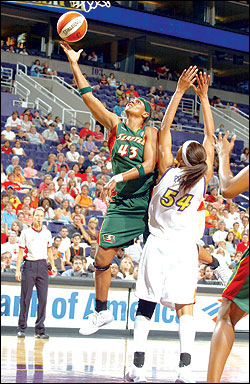Scrawling her signature for eager fans is a dream come true. After practice, Seattle Storm forward Alicia Thompson and her teammates head over to a table to sign basketballs, posters, and other team memorabilia. “I can remember when I was in middle school, practicing my autograph for when I became a famous basketball player,” Thompson says. “To actually be in the position to do that, I mean, it’s just great, and I’m sure that’s the same for a lot of women in this league.”
Nine years ago, women stepped on the court as professional athletes with the birth of the WNBA. Five years ago, the Seattle Storm was born, and last year the team brought home Seattle’s first professional sports championship in 25 years. They have a fan base. Sue Bird and Lauren Jackson are household names.
The WNBA is on its way, right? Sort of. There’s an unanswered million-dollar question: Where’s the cash?
The average NBA salary rose to $3.17 million per player for the 1999–2000 season, while the average WNBA salary over the same period was $55,000, according to the Women’s Sports Foundation. That means the men are making about 58 times more money than the women. Only a few WNBA players make six-digit salaries, and that’s only because they play year-round—in the U.S. during the WNBA summer season and in other countries during the off-season—and participate in marketing for the league.
Seattle Storm guard Sue Bird was only a junior in high school when the WNBA started, and now she is a poster child for women’s athletics. Just drive past Niketown downtown and see for yourself. At the beginning of her rookie year, Bird was paid $57,500. By now she has to be making a little more, but not more than $87,000, which was the maximum WNBA salary for 2004, according to InsideHoops.com. Bird and her teammates got a mere $10,000 bonus after winning the championship last season.
Thompson sees this inequality and hopes to be a part of changing it. “Even though we’re not getting it now, one day the other women will,” Thompson says. “To be a part of that and set the stage for that is an honor.”
Storm coach Anne Donovan says that is what the game is all about right now— setting the stage for up-and-coming female athletes. Meanwhile, she is just happy there is a league and more opportunity for women athletes to get involved. “It’s about growth, and these players are about setting the tone for the next generation of players,” says Donovan.
A minimal salary for women does not plague only the world of basketball. In 2000, a Women’s Professional Football League was created. Never heard of it? Not a surprise. The league has 19 teams in 12 states. When it launched, each player took home $100 per game. Compare that to star quarterback Tom Brady’s $5 million salary with the New England Patriots. When it comes down to it, the men draw the sellout crowds, whether it’s at KeyArena or the millions lounging on couches at home.
The Seattle Storm, whose season ends Aug. 27 at home against the Phoenix Mercury, average about 7,000 fans per game, while the Sonics average 15,000. For most Storm games, upper bowl seating is not even offered. As for ticket prices, the Sonics charge anywhere from $10 to $120 per ticket. The Storm also start out with $10 tickets but only charge as much as $35 for high-end tickets.
Another factor is airtime. Out of 82 games the Sonics play in a season, 71 are televised locally on Fox Sports Northwest. About five or six of the Storm’s 34 games are broadcast on FSN. In the real world today, men’s sports are just more popular.
But women across the country are making leaps and bounds (or rebounds) to prove that anything you can do, we can do better. Take Danica Patrick, who finished fourth in the Indianapolis 500—she was in the lead with 10 laps to go. And then there is Michelle Wie, who had a close shot at a PGA Tour event. She is a 15-year-old girl kicking the butts of grown men. And tennis has always been a popular women’s sport. Venus Williams is making about $12.5 million a year—that’s $6,250 an hour, compared to a top WNBA player’s hourly wage of $43.50. Do you know what this means? Venus Williams could have purchased about 140 Barbie dolls before a top WNBA player could afford to buy her first Barbie, according to Salary.com. Man, these WNBA players just picked the wrong sport.
Storm players say they have seen some growth in the number of fans coming out to cheer them on. “Here, the fan support has picked up,” says Thompson. “I think people are just grasping hold of what women’s basketball is all about.”





